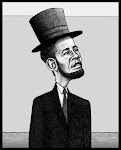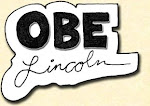[UPDATED WITH NEW LINKS]

I drew the above picture freehand, obviously copying the Shepard Fairey Obama HOPE poster, which copied Mannie Garcia's (or the AP's) photo. I changed the image to add Baxter Orr's SARS mask. I used ink pens that weren't the same color as the Fairey poster, so I put it on Photoshop to adjust the colors to be closer to Fairey's colors (and to deal with the shortcomings of my crappy scanner). Any difference between this image and Fairey's image is a result of my failure to draw it perfectly freehand, not a result of a conscious attempt to make a significant transformation.
So, am I guilty of copyright infringement?
If you haven't been following the AP/Garcia v Fairey copyright lawsuit(s?), then you're missing out. I'm not a lawyer, but it's pretty fascinating stuff in terms of the questions that arise about art, photography, copyright, ownership, access, appropriation, theft, hypocrisy, consistency, ethics, greed, and creation. Not a bad list, eh? Check it out:
AP threatens to sue Fairey.
Fairey sues the AP.
Fairey's Obey Giant website.
Fairey on Charlie Rose.
Hypocrisy? Fairey threatens to sue Orr.
Orr had appropriated and changed Obey Giant with a SARS mask.
A discussion on copyright and fair use law.
The law.
More discussion on the law.
A blogging copyright lawyer weighs in.
Another blogging copyright lawyer weighs in.
The debate is on,
And on,
And on,
And on,
And on.
And then there's parody. One of the landmark cases about parody is Leibovitz v Paramount Pictures, in which the Naked Gun 33&1/3 parody of the pregnant Demi Moore Vanity Fair cover was upheld as fair use.
Here are a few other interesting cases.
And if all that doesn't have you confused yet, check out this article that points out that parody is protected, but satire is not. I hope the writer of that article, Jesse Walker, won't mind if I quote this insightful analysis:
"In the press or the academy, it's considered normal for more than one interpretation of a piece of art to coexist. In a courtroom, only one interpretation will enjoy the blessing of the law, and there's no guarantee that a judge playing critic for a day will agree with [the defendant's] subtle analysis."



2 comments:
This image was mentioned on myartspace.com.
and on geniocity.com
Post a Comment